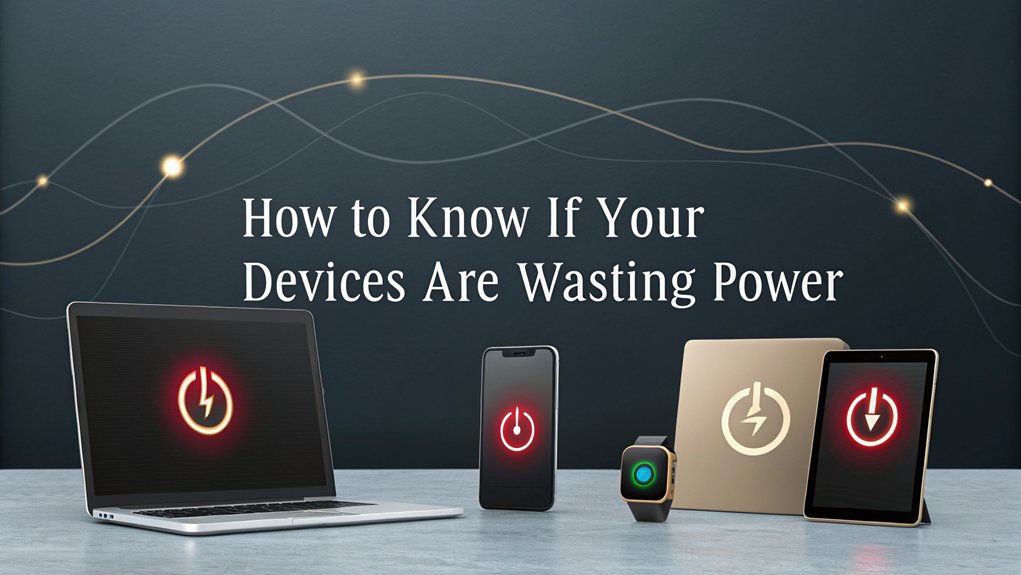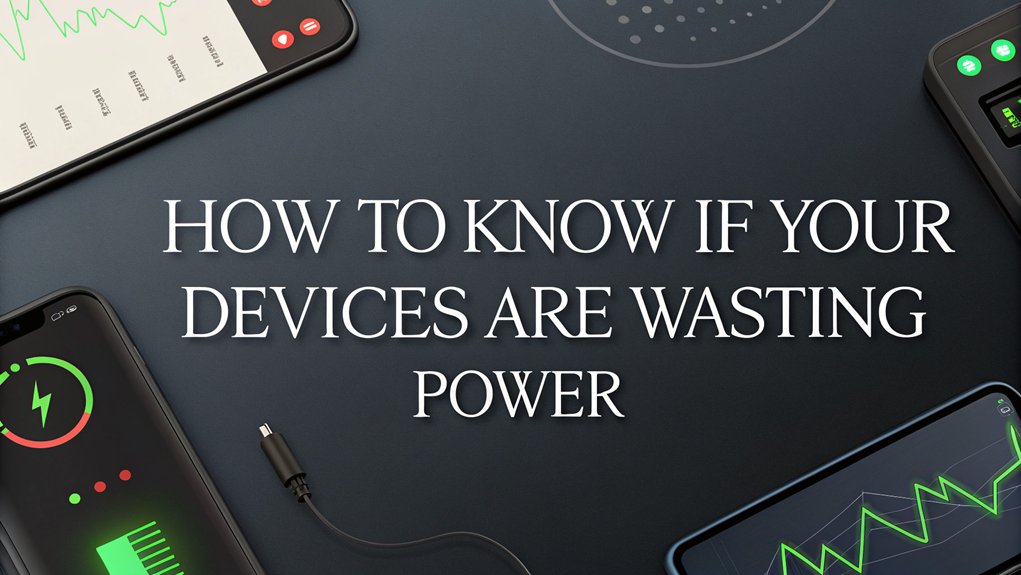To know if your devices are wasting power, use electricity usage monitors or smart plugs to measure standby power consumption. High energy draw devices, such as set-top boxes and gaming consoles, often consume significant power even when idle. Perform home energy audits to identify and replace inefficient appliances, and consider power strips with timers or smart features to optimize energy use. Learn effective strategies to curb phantom power and boost your home’s energy efficiency.
Key Facts Summarized
- Use electricity usage monitors to measure your devices’ active and standby power consumption.
- Identify devices frequently in standby mode, like set-top boxes and gaming consoles, which often waste energy.
- Smart outlets provide real-time energy usage data and insights via connected apps.
- Conduct home energy audits to pinpoint high-energy draw devices contributing to phantom power.
- Utilize an Energy Vampire Calculator to estimate potential energy waste from plugged-in devices.
Understanding Phantom Power and Its Impact
Have you ever wondered why your electricity bill is higher than expected, even when you’re not using much power? The culprit might be phantom power, also known as energy vampires.
These are devices like smart bulbs and gaming consoles that consume energy even when turned off. Shockingly, up to 75% of a plugged-in device’s electricity usage occurs while it’s idle, contributing considerably to energy costs.
An energy usage monitor can help identify these silent power drainers. By understanding this, you can enhance energy efficiency in your home.
Strategies such as unplugging devices or employing smart plugs to manage energy usage can curb this wastage. Reducing phantom power is an impactful step towards lowering your electricity bills and optimizing energy consumption.
Tools for Measuring Device Energy Consumption
To effectively manage your home’s energy efficiency, leveraging tools that measure device energy consumption is essential.
An electricity usage monitor, like the P3 Kill A Watt EZ, measures power consumption in active and standby modes, revealing energy waste.
Smart Outlets with energy monitoring capabilities offer real-time insights into energy usage via apps, helping you pinpoint devices contributing to phantom power.
For a broader perspective, consider whole-house monitoring systems installed at the junction box; they track overall energy consumption and detect high usage patterns.
Individual appliance meters, plugged directly into outlets, let you measure specific devices’ energy usage over time.
Finally, the Energy Vampire Calculator estimates potential energy waste from plugged-in devices, offering an extensive view of your energy losses.
Identifying High Energy Draw Devices
With an understanding of the tools available for measuring energy consumption, focusing on identifying high energy draw devices becomes a priority. Devices like set-top boxes and gaming consoles often waste energy in standby mode, consuming unnecessary power. Smart light bulbs and kitchen appliances contribute considerably to home energy use even when they’re off. On average, 75% of the electricity these devices use happens in standby, underscoring the need to monitor their consumption.
Utilize electricity usage monitors to determine each device’s energy use. This data aids in identifying and managing power-hungry devices.
| Device Type | Standby Power Usage (%) |
|---|---|
| Set-top Boxes | High |
| Gaming Consoles | High |
| Smart Light Bulbs | Moderate |
| Kitchen Appliances | Moderate |
Awareness of these patterns helps reduce wasting energy effectively.
Strategies to Minimize Phantom Power Usage
Although phantom power usage can be a hidden drain on your electricity bill, there are effective strategies to combat this issue.
Start by unplugging devices when they’re not in use, as standby power can account for up to 10% of your home’s energy use.
Utilizing power strips with timers or auto shut-off features can help you manage multiple devices at once, making it easier to control energy consumption.
Consider switching to ENERGY STAR-certified appliances to further reduce energy use, as they offer lower standby power.
Implementing smart plugs can provide real-time data and scheduling options for efficient energy management.
Finally, conducting a home energy audit will identify high-energy draw devices, helping you prioritize unplugging efforts and optimize your energy strategy.
Smart Plugs and Their Role in Energy Efficiency
Addressing phantom power usage effectively involves integrating technology that streamlines energy management. Smart plugs are a pivotal tool in this process, allowing you to monitor energy consumption in real-time.
With these devices, you can track energy usage and identify which appliances are drawing power even when they’re not in use. This insight enables you to take corrective action to reduce phantom power.
Many smart plugs also offer scheduling capabilities, letting you automatically turn off devices during inactivity, further minimizing waste.
By using smartphone apps, you can gain detailed insights into your energy consumption patterns, pinpointing opportunities for significant energy savings.
Over time, you’ll be able to calculate energy costs and identify high-energy draw devices, facilitating smarter power management and reduced electricity bills.
Practical Steps to Improve Home Energy Efficiency
When aiming to improve home energy efficiency, focusing on practical steps can yield significant savings.
Start by tackling phantom electricity use. Unplugging devices when they’re not in use can slash up to 10% of your home’s energy costs.
Consider these steps:
- Utilize Power Strips: Invest in power strips with timers or smart features, allowing you to automate the shutdown of multiple devices, effectively cutting electricity usage.
- Switch to ENERGY STAR: Upgrade to ENERGY STAR-certified appliances. These devices are designed to use less energy without sacrificing performance, reducing your overall consumption.
- Conduct Energy Audits: Regular home energy audits help pinpoint areas of waste, providing tailored strategies to enhance efficiency.
Taking these steps guarantees you’re maximizing energy savings and minimizing waste.
Monitoring Overall Household Energy Consumption
Understanding your household’s energy consumption patterns is essential for optimizing efficiency and reducing waste. Monitoring your energy consumption can reveal usage trends, like peak times and the impact of standby power from appliances.
Installing a whole-house electrical monitoring system provides insights into total consumption and identifies high-energy appliances contributing to phantom power. Smart meters, often provided by utilities, offer real-time data, allowing you to track electricity usage hourly and adjust accordingly.
Furthermore, individual appliance meters can pinpoint which devices are major energy culprits. By being aware of overall energy consumption through these tools, you can lower your electricity bill and empower yourself to target specific areas for reducing unnecessary energy use.
This precision helps you make informed decisions about energy efficiency.
Engaging in Energy-Saving Practices
Even though energy-saving practices might seem minor individually, collectively they can greatly impact your household’s electricity consumption.
By targeting phantom power consumption, you could reduce your energy costs by up to 10%. Here’s how:
- Use power strips: Opt for models with timers or auto shut-off to manage multiple devices, ensuring they’re off when not needed.
- Monitor usage: Employ electricity usage monitors to track which appliances drain energy unnecessarily, guiding you on when to unplug them.
- Upgrade appliances: Replace older units with ENERGY STAR-certified models to enhance efficiency and lower bills.
Additionally, activate power-saving settings on devices like computers and TVs to minimize standby energy draw.
Implementing these energy-saving practices not only boosts efficiency but also contributes to environmental conservation.
Frequently Asked Questions
How Can I Tell What Is Draining My Electricity?
You’ll identify what’s draining your electricity by using an electricity usage monitor to measure device power consumption in standby and operation modes.
Set-top boxes and gaming consoles might consume energy even when off. Track usage patterns during your absence or at night.
Smart plugs with energy monitoring features provide real-time data.
Conduct a professional home energy audit to assess efficiency and uncover phantom power sources for actionable reduction strategies.
How Do I Know if I’m Using a Lot of Electricity?
To determine if you’re using a lot of electricity, start by analyzing your monthly bill for kWh consumption.
Compare it to the average household usage of 1,000 kWh.
Use electricity monitors or smart plugs on devices to track individual consumption, focusing on those in standby mode.
Choose Energy Star appliances to reduce usage.
Check for phantom power from idle devices.
Adjust your usage patterns during peak hours to manage costs effectively.
How Can I Tell How Much Power a Device Is Using?
To determine a device’s power usage, plug it into an electricity usage monitor. This tool provides real-time kWh data.
Alternatively, use smart plugs with energy monitoring features via a smartphone app. Individual appliance meters offer precise readings by plugging the device into the meter.
For a thorough view, consider a whole-house monitoring system. These methods allow you to analyze and manage your energy consumption effectively.
Does Leaving Stuff Plugged in Use Electricity?
Ever noticed your electricity bill climbing unexpectedly? Coincidentally, leaving devices plugged in does use electricity, even if they’re off.
This phenomenon, known as phantom power, can make up about 10% of your energy costs. Devices like smart bulbs and gaming consoles draw power in standby mode.
Analyze your usage: power strips or smart plugs can help manage this by letting you switch off multiple devices at once, saving energy and money.
Conclusion
By treating energy efficiency like a detective solving a mystery, you’ll uncover the hidden culprits of phantom power in your home. Utilize tools to measure energy use and smart plugs to manage consumption effectively. Identifying high-energy devices and adopting simple energy-saving practices will help you minimize waste. Monitor your household’s energy habits to guarantee long-term efficiency. With these strategies, you’ll not only save money but also contribute to a more sustainable future.

